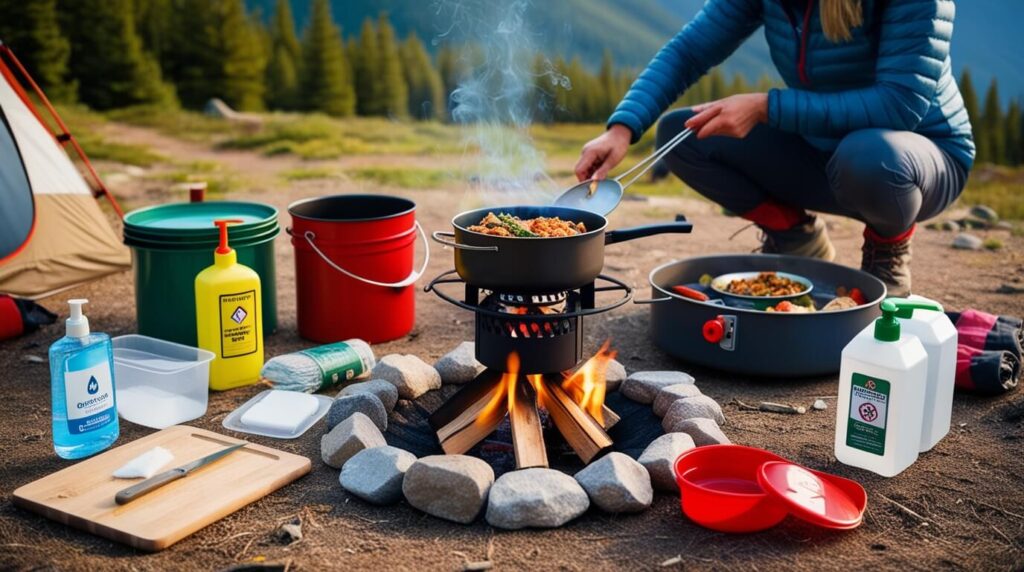Introduction:
Ever had a camping trip ruined by food poisoning or a close call with a campfire? I’ll never forget the time our family camping trip turned into a nightmare when my uncle’s “perfectly cooked” chicken left half our group sick for days!
According to the CDC, foodborne illnesses spike during summer camping season, with improper food handling being the top culprit. But here’s the thing – most camping cooking disasters are completely preventable with the right knowledge and preparation.
Whether you’re a weekend warrior or a seasoned outdoor enthusiast, mastering camp cooking safety tips isn’t just about avoiding stomach bugs. It’s about protecting your family, preventing dangerous fires, and ensuring every outdoor meal becomes a cherished memory instead of a cautionary tale. Let’s dive into the essential camp cooking safety tips that’ll keep your camp kitchen running smoothly and safely!
The Growing Importance of Camp Cooking Safety in 2025
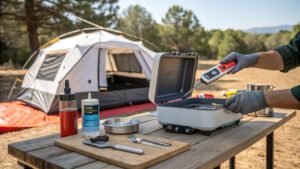
Let’s face it—we’re living in times when food safety awareness has reached new heights. The statistics are sobering: 1 in 6 Americans get sick with a foodborne illness every year, and that risk increases significantly when we’re cooking outdoors. When you’re miles from the nearest hospital, prevention becomes absolutely crucial.
What makes camp cooking particularly challenging is that we’re often working with limited resources, unpredictable weather, and equipment that’s far from our familiar home kitchens. Add to this the fact that food poisoning is a real risk when taking food outside the home, especially in warmer weather, and you’ll understand why I’ve become passionate about spreading awareness on this topic.
Understanding the Unique Risks of Outdoor Cooking
Camp cooking presents challenges that simply don’t exist in our home kitchens. Temperature control becomes a constant battle—your cooler is working overtime to keep things cold while you’re trying to maintain proper cooking temperatures over an open flame or camp stove. Cross-contamination risks multiply when you’re working with limited cutting boards and washing facilities.
I’ve learned that the key is understanding these unique challenges and planning accordingly. Unlike home cooking, where you have instant access to running water and refrigeration, camp cooking requires a completely different mindset. Every decision—from meal planning to cleanup—needs to factor in safety.
The weather plays a huge role too. What seems like a minor inconvenience—a sudden temperature spike or unexpected rain—can turn into a food safety nightmare if you’re not prepared. I’ve seen perfectly planned meals turn dangerous when campers didn’t account for changing conditions.
The Foundation: Pre-Trip Planning and Preparation
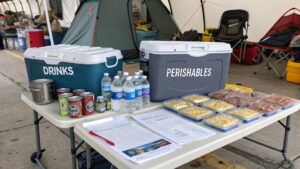
My approach to camp cooking safety tips starts long before I leave home. I’ve developed a systematic approach to meal planning that prioritizes safety without sacrificing the joy of outdoor cooking. It all begins with understanding what foods travel well and which ones are asking for trouble.
Menu Planning with Safety in Mind
I always start by categorizing my planned meals into three groups: shelf-stable items that can handle temperature fluctuations, refrigerated items that need careful temperature control, and fresh ingredients that need to be used quickly. This simple categorization helps me plan which meals to cook first and which can wait.
Non-perishable items like canned goods, dried pasta, and shelf-stable proteins form the backbone of my camping menu. These items give me flexibility and peace of mind, knowing that even if my cooling system fails, I still have safe food options available.
For perishable items, I’ve learned to be ruthless about freshness dates. If something is even close to its expiration date at home, it doesn’t make the camping trip. The stress of outdoor conditions can accelerate spoilage, and I’d rather err on the side of caution.
Smart Packing Strategies
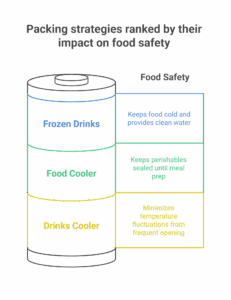
The way you pack your cooler can make or break your food safety efforts. I use a two-cooler system when possible: one for drinks and frequently accessed items, and another for perishable foods that stays sealed until meal prep time. This prevents the constant opening and closing that causes temperature fluctuations.
I also pre-freeze water bottles and juice boxes to use as ice packs. They serve double duty—keeping food cold and providing clean drinking water as they melt. It’s a simple trick that maximizes cooler space while ensuring food safety.
Critical Temperature Control: The Make-or-Break Factor
Temperature control is where most camp cooking safety issues begin. The danger zone—temperatures between 40°F and 140°F—is where bacteria multiply rapidly, turning safe food into a health hazard in just hours. Understanding and respecting this principle has saved countless camping trips for me and my family.
Keeping Cold Foods Cold
I’ve invested in a quality cooler thermometer, and I check it religiously. If the internal temperature rises above 40°F, I know I need to take action immediately. This might mean adding more ice, finding shade for the cooler, or using frozen drinks as ice packs to bring the temperature back down.
The location of your cooler matters more than most people realize. I always keep mine in the shade, elevated off hot ground, and covered with reflective material or additional insulation. Even small details like this can extend the safe storage time of your perishable foods by hours.
Ensuring Proper Cooking Temperatures
A food thermometer is non-negotiable in my camping kit. I’ve seen too many campers rely on visual cues alone, which can be unreliable, especially when cooking over an open fire. Beef, pork, and lamb should reach 160°F, while poultry needs to hit 165°F to be safe for consumption.
What’s challenging about camp cooking is that heat distribution is often uneven. That perfectly browned burger might still be raw in the center, and you’d never know without a thermometer. I always let meat rest for at least three minutes after cooking, which allows the temperature to stabilize and ensures more even doneness.
Food Handling and Cross-Contamination Prevention
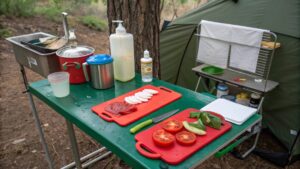
Cross-contamination is perhaps the sneakiest danger in camp cooking. With limited workspace and equipment, it’s easy to make mistakes that would never happen in your home kitchen. I’ve developed strict protocols that have become second nature over years of camping.
The One-Board Challenge
Most campers work with a single cutting board, which presents obvious cross-contamination risks. My solution is simple but effective: I always prep fruits and vegetables first, then meat. After cutting meat, I thoroughly disinfect the cutting surface with a diluted bleach solution or antibacterial wipes.
I also designate specific utensils for raw meat and never use them for other ingredients without proper cleaning. Color-coded cutting boards are worth their weight in gold if you have the space—I use a small green board for vegetables and a red one for raw meat.
Hand Hygiene in the Wilderness
Clean hands are crucial, but maintaining proper hand hygiene while camping requires planning. I set up a dedicated hand-washing station with biodegradable soap, hand sanitizer, and paper towels in an obvious location where everyone in our group knows to find it.
I’ve learned to be almost obsessive about hand washing—before handling food, after touching raw meat, after using the bathroom, and especially after handling camping equipment that might be contaminated with dirt or animal waste. It might seem excessive, but when medical help is potentially hours away, prevention is everything.
Safe Cooking Methods and Equipment
The cooking methods and equipment you choose can significantly impact food safety. Over the years, I’ve experimented with various approaches and learned which techniques minimize risk while maximizing flavor and convenience.
Camp Stove vs. Open Fire Cooking

Both methods have their place, but they require different safety approaches. When using camping stoves, I always cook over low heat when possible to conserve fuel and ensure even cooking. I use designated cookware that won’t shatter from high heat and keep kids and pets safely away from hot surfaces.
Open fire cooking requires even more vigilance. I always use designated fire pits when available and create a safe cooking environment by clearing the area of flammable materials. The key is maintaining consistent heat, which takes patience and practice.
Essential Safety Equipment
My camp cooking safety kit includes several non-negotiable items: a reliable food thermometer, a cooler thermometer, antibacterial wipes, hand sanitizer, and a basic first aid kit with burn treatment supplies. I also carry extra water specifically for cleaning and sanitizing.
Recently, there have been recalls of camping cooking equipment due to burn and scald hazards, which reminds us that even our equipment can pose risks. I regularly check for product recalls and inspect my gear before each trip.
Water Safety and Sanitation
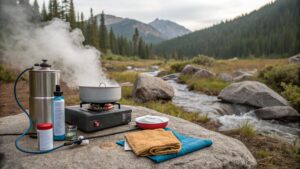
Clean water is the foundation of camp cooking safety, yet it’s often overlooked. I’ve learned that assumptions about water quality can be dangerous, even in seemingly pristine wilderness areas.
Water Treatment and Purification
I never assume that natural water sources are safe, regardless of how clean they appear. I carry multiple water purification methods: boiling, water purification tablets, and a quality portable filter. For cooking, I only use water that I’ve personally treated or know to be from a safe source.
Boiling remains the most reliable method for killing harmful bacteria and parasites. I bring water to a rolling boil for at least one minute (three minutes at altitudes above 6,500 feet) and use this treated water for all cooking and cleaning purposes.
Cleaning and Sanitizing in the Field
Effective cleaning requires more than just rinsing with water. I use hot water with biodegradable soap and thoroughly scrub all equipment with a clean cloth or sponge. For sanitizing, I follow up with a diluted bleach solution or antibacterial wipes.
I’ve learned to clean as I go rather than letting dishes pile up. This prevents bacteria from multiplying on dirty surfaces and makes the cleaning process more manageable. It also means I always have clean equipment ready for the next meal.
Comparing Indoor vs. Outdoor Cooking Safety Challenges
The differences between home and camp cooking safety are significant and worth understanding in detail. This comparison helps illustrate why outdoor cooking requires such a different approach:
| Safety Factor | Indoor Cooking | Outdoor Cooking | Key Implications |
|---|---|---|---|
| Temperature Control | Consistent refrigeration and heating | Variable conditions, limited cooling | Requires constant monitoring and backup plans |
| Water Access | Clean, unlimited water supply | Limited, potentially contaminated sources | Must plan for purification and conservation |
| Workspace Cleanliness | Controlled, sanitizable environment | Exposed to elements, limited cleaning | Need portable sanitization solutions |
| Equipment Reliability | Consistent power and heat sources | Weather-dependent, fuel limitations | Requires backup methods and flexible planning |
| Food Storage | Stable refrigeration and pantry | Temperature fluctuations, space limits | Must prioritize perishables and timing |
| Waste Management | Municipal disposal systems | Pack-it-out requirements | Affects food choices and preparation methods |
| Emergency Response | Quick access to medical care | Potentially hours from help | Prevention becomes absolutely critical |
This comparison reveals why I’ve developed such detailed protocols for camp cooking. The stakes are simply higher when you’re far from medical assistance and working with limited resources.
Personal Protective Equipment and Clothing Safety
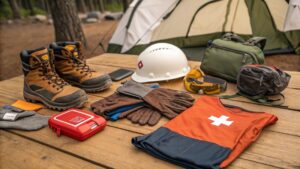
What you wear while camp cooking matters more than most people realize. I learned this lesson when my synthetic jacket briefly caught fire from a stray spark, and I’ve been much more conscious of clothing choices ever since.
Appropriate Clothing for Camp Cooking
I always wear natural fiber clothing when cooking around open flames—cotton and wool are much safer than synthetic materials that can melt and cause severe burns. Closed-toe shoes are non-negotiable, and I tie back long hair to prevent it from catching fire.
Loose clothing is another hazard I’ve learned to avoid. Baggy sleeves can easily catch fire or knock over cooking equipment, creating dangerous situations. I opt for fitted clothing and roll up sleeves when working near flames.
Protective Gear and Safety Tools
Heat-resistant gloves are essential, but I’ve learned that regular work gloves aren’t sufficient. I invest in proper heat-resistant gloves designed for cooking and keep them easily accessible during meal preparation. I also carry a basic first aid kit with burn treatment supplies—because accidents can happen even with the best precautions.
A reliable flashlight or headlamp is crucial for evening cooking sessions. Trying to cook in poor lighting is a recipe for accidents, from cuts to burns to food safety mistakes. Good lighting isn’t a luxury—it’s a safety necessity.
Fire Safety and Burn Prevention
Fire safety extends beyond just preventing forest fires—it’s about protecting yourself and your fellow campers from burns and other fire-related injuries. Over the years, I’ve developed a healthy respect for the power of fire and the importance of proper safety protocols.
Building and Maintaining Safe Cooking Fires
I always check fire restrictions before any camping trip and respect all posted guidelines. When fires are allowed, I use established fire rings when available and create proper fire containment when they’re not. The key is building a fire that you can control—not too large, with adequate clearance from flammable materials.
I keep a bucket of water and a shovel nearby whenever I have a fire going. These aren’t just for extinguishing the fire at the end of the evening—they’re safety tools that can prevent a small accident from becoming a major emergency.
Proper Fire Extinguishing Techniques
Complete fire extinguishing is crucial for safety and environmental protection. I always stir ashes to ensure complete burnout and douse everything with water. If water isn’t available, I cover the coals with sand or dirt, but water is always the preferred method.
I’ve made it a habit to check the fire site one final time before leaving the area or going to sleep. A seemingly dead fire can rekindle hours later, especially in windy conditions. This final check has prevented potential disasters on several occasions.
Food Storage and Wildlife Safety

Proper food storage serves dual purposes: maintaining food safety and protecting both wildlife and campers. I’ve learned that these two goals often align—practices that keep food safe from bacterial contamination also tend to keep it away from curious animals.
Bear-Safe Food Storage
Bear boxes are essential in bear country, but proper food storage is important everywhere. Even in areas without large predators, proper storage prevents contamination from smaller animals and insects that can carry harmful bacteria.
I store all food, toiletries, and scented items in approved containers, even if bears aren’t a concern. This protects against rodents and insects that can contaminate food supplies and create health hazards. It’s also good practice for developing habits that serve you well in all camping environments.
Effective Food Storage Systems
My food storage system varies depending on the camping environment, but the principles remain consistent: keep food sealed, temperature-controlled, and protected from contamination. In car camping situations, I use hard-sided coolers with tight-fitting lids. For backpacking, I rely on approved food storage containers and proper hanging techniques.
I’ve found that organization is key to effective food storage. I group foods by type and use date, which helps me use items in the proper order and quickly identify anything that might be approaching unsafe conditions.
Recognizing and Responding to Food Safety Emergencies
Despite all precautions, food safety emergencies can still occur. Knowing how to recognize and respond to these situations can mean the difference between a minor inconvenience and a serious health crisis.
Signs of Food Poisoning
Food poisoning symptoms typically include nausea, vomiting, diarrhea, stomach cramps, and fever. In a camping environment, these symptoms can be particularly dangerous due to dehydration risks and limited access to medical care. I’ve learned to take any signs of food poisoning seriously and respond quickly.
The key is early recognition and immediate response. If someone in our group shows signs of food poisoning, I immediately focus on preventing dehydration and getting them to medical care if symptoms are severe or persistent.
Emergency Response Protocols
My emergency response plan includes several key elements: maintaining hydration for the affected person, isolating potentially contaminated food, and having a plan for reaching medical care if needed. I always carry oral rehydration salts and have emergency contact information readily available.
I’ve also learned the importance of preventing cross-contamination when someone is ill. This means separate eating utensils, careful hand hygiene, and proper disposal of waste to prevent the illness from spreading to other group members.
Special Considerations for Different Camping Styles

Different types of camping present unique food safety challenges. My approach has evolved to account for these differences, and I’ve developed specific protocols for various camping styles.
Car Camping vs. Backpacking
Car camping offers more storage space and equipment options, but it can also lead to overconfidence about food safety. With easy access to large coolers and multiple cooking devices, it’s tempting to prepare more complex meals without adequate safety precautions.
Backpacking requires ultra-careful planning due to weight and space constraints. Every item must serve multiple purposes, and backup plans are essential. I focus on shelf-stable foods and simple cooking methods that minimize contamination risks.
Group Camping Considerations
Cooking for large groups amplifies every food safety challenge. More food means more opportunities for contamination, and coordinating safe practices among multiple people requires clear communication and designated responsibilities.
I’ve learned to designate specific people for specific tasks—one person handles raw meat, another manages vegetables, and someone else oversees cooking temperatures. This reduces confusion and ensures that safety protocols are consistently followed.
Seasonal Considerations and Weather Challenges
Weather conditions significantly impact food safety requirements. I’ve adapted my approaches based on seasonal challenges and learned to adjust my protocols accordingly.
Hot Weather Camping
Summer camping presents the greatest food safety challenges due to accelerated bacterial growth in high temperatures. I plan more meals using shelf-stable ingredients and focus on foods that can be consumed quickly after cooking.
I also adjust my meal timing to avoid cooking during the hottest parts of the day when possible. Early morning and evening cooking sessions are not only more comfortable but also safer from a food handling perspective.
Cold Weather Considerations
Cold weather camping brings different challenges, including the risk of food freezing and the need for higher calorie intake. I’ve learned to balance the convenience of frozen foods with the safety concerns of proper thawing and cooking.
Water management becomes critical in freezing conditions, as water sources may be unavailable and storage containers can freeze. I plan for these challenges by carrying extra water and insulating storage containers.
Technology and Modern Solutions

Modern technology offers several tools that can enhance camp cooking safety. I’ve embraced these innovations while maintaining traditional safety practices as backup methods.
Digital Thermometers and Monitoring
Instant-read digital thermometers have revolutionized my approach to food safety. They provide quick, accurate readings that help ensure proper cooking temperatures. I carry multiple thermometers as backups, since electronic devices can fail in outdoor conditions.
Some newer models offer wireless monitoring capabilities, allowing me to monitor food temperatures without constantly opening coolers or checking cooking food. While these aren’t essential, they can provide valuable peace of mind.
Solar Chargers and Power Banks
Reliable power sources for electronic devices have become increasingly important for safety equipment. Solar chargers and power banks ensure that my thermometers, lights, and communication devices remain functional throughout extended camping trips.
I’ve learned to balance the convenience of electronic devices with the reliability of non-electronic backup methods. Technology enhances safety, but it shouldn’t replace fundamental safety practices.
Teaching Children About Camp Cooking Safety
Involving children in camp cooking can be rewarding and educational, but it requires extra attention to safety protocols. I’ve developed approaches that teach safety while maintaining the fun and learning aspects of outdoor cooking.
Age-Appropriate Safety Lessons
I start with basic concepts like hand washing and staying away from hot surfaces, then gradually introduce more complex safety principles as children mature. Making safety fun through games and hands-on demonstrations helps children remember important concepts.
Clear boundaries and consistent enforcement are essential when children are involved in camp cooking. I establish safety zones around cooking areas and assign specific roles that match each child’s age and ability level.
Creating Safe Learning Environments
I involve children in meal planning and preparation at home before camping trips, which helps them understand safety principles in a controlled environment. This preparation makes them more aware of safety considerations when we’re actually camping.
Supervision levels vary based on the child’s age and experience, but I never leave children unsupervised around cooking equipment or open flames. The goal is to teach independence while maintaining safety.
Cost-Benefit Analysis of Safety Investments
Investing in quality safety equipment and practices might seem expensive, but the costs pale in comparison to the potential consequences of food poisoning or accidents while camping. I’ve learned to view safety investments as insurance rather than expenses.
Essential vs. Optional Safety Equipment
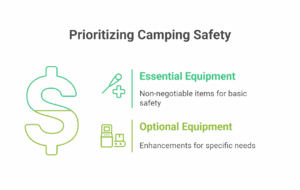
My essential safety equipment includes food thermometers, first aid supplies, water purification methods, and proper food storage containers. These items are non-negotiable and worth investing in quality versions that will last for years.
Optional equipment like digital monitoring systems and specialized containers can enhance safety but aren’t absolutely necessary. I recommend starting with essential items and adding optional equipment based on your specific camping style and frequency.
Long-term Health and Enjoyment Benefits
The true value of camp cooking safety investments becomes clear when you consider the alternative costs. A single case of severe food poisoning can result in medical bills, lost vacation time, and ruined camping experiences that far exceed the cost of proper safety equipment.
Beyond financial considerations, proper safety practices ensure that camping remains enjoyable for everyone involved. There’s no price tag on the peace of mind that comes from knowing you’ve taken appropriate precautions.
Looking Ahead: Future Trends in Camp Cooking Safety

As camping continues to grow in popularity and technology advances, I expect to see continued evolution in camp cooking safety practices and equipment. Understanding emerging trends helps me stay current with best practices.
Technological Advances
Smart cooking devices and monitoring systems are becoming more portable and affordable. These technologies can enhance safety by providing more precise temperature control and monitoring capabilities.
However, I believe the fundamental principles of food safety will remain constant. Technology should enhance these principles rather than replace them.
Environmental Considerations
Growing environmental awareness is influencing camping practices, including food safety approaches. Biodegradable cleaning products and sustainable food storage solutions are becoming more important considerations.
Leave No Trace principles increasingly influence food safety practices, as proper waste management and environmental protection align with health and safety goals.
Conclusion:
After years of camping and countless meals cooked under the stars, I’ve learned that the best safety practices are those that become second nature. The goal isn’t to create fear around camp cooking but to develop habits that allow you to enjoy outdoor adventures with confidence.
The key insights I’ve shared—from understanding temperature control to recognizing the unique challenges of outdoor cooking—form a foundation that can adapt to any camping situation. Whether you’re car camping with a large group or backpacking solo, these principles remain constant.
Remember that food safety while camping isn’t just about preventing illness—it’s about ensuring that your outdoor adventures create positive memories rather than cautionary tales. Every precaution you take is an investment in the success of your trip and the safety of your fellow campers.
The statistics showing increased food-related illnesses in 2024 serve as a reminder that vigilance remains important. But with proper planning, appropriate equipment, and consistent safety practices, you can minimize risks while maximizing the joy of outdoor cooking.
As we move forward in 2025 and beyond, I encourage you to view camp cooking safety not as a burden but as an essential skill that enhances your outdoor experiences. Start with the fundamentals, invest in quality safety equipment, and develop habits that serve you well in any camping situation.
The wilderness offers incredible opportunities for memorable meals and meaningful connections. By prioritizing safety, you ensure that these experiences remain positive and that everyone returns home with stories of adventure rather than tales of avoidable emergencies.
Take these lessons to heart, adapt them to your specific camping style, and remember that the best outdoor meals are those prepared and enjoyed safely. Here’s to many seasons of delicious, safe, and memorable camp cooking adventures!
Frequently Asked Questions
Q1: What’s the most important piece of safety equipment for camp cooking?
A reliable food thermometer is absolutely essential. You can’t safely determine if meat is properly cooked just by looking at it, especially when cooking over uneven heat sources like campfires.
I always carry at least two thermometers as backups, since they’re small, inexpensive, and can prevent serious foodborne illness.
Q2: How long can I safely keep food in a cooler while camping?
This depends entirely on maintaining proper temperature. If your cooler stays below 40°F, perishable foods can last 2-4 days. However, I recommend using perishables within the first 1-2 days to be safe. Always check your cooler thermometer regularly and have a backup plan if temperatures rise above the safe zone.
Q3: Is it safe to cook with water from natural sources like streams or lakes?
Never cook with untreated water from natural sources, regardless of how clean it appears. Even pristine-looking water can contain harmful bacteria and parasites.
Always boil water for at least one minute (three minutes above 6,500 feet elevation) or use water purification tablets before using it for cooking or cleaning.
Q4: What should I do if someone in my camping group gets food poisoning?
Focus immediately on preventing dehydration by encouraging small, frequent sips of clean water or oral rehydration solutions. Isolate any potentially contaminated food and practice strict hand hygiene to prevent spread.
If symptoms are severe, persistent, or the person shows signs of dehydration, seek medical attention immediately—don’t wait to see if it gets better.
Q5: Can I prepare some food at home to make camp cooking safer?
Absolutely! Pre-cooking items like rice, pasta, or even partially cooking meats at home can significantly reduce cooking time and contamination risks at camp.
Just make sure to cool pre-cooked foods quickly, store them properly, and reheat to safe temperature. I often pre-chop vegetables and pre-marinate meats at home to minimize handling time at the campsite.
Additional Resources
- Titanium Camping Cookware: Learn about how important it is to upgrade your camp kitchen with this premium material.
- Minimalist Camp Kitchen Setup: This will help you create a more efficient outdoor cooking system.
- How to Make Dehydrated Camping Meals: Learn how to pack food that is lightweight, doesn’t spoil and tastes good.
- The Ultimate Guide to Long-Term Camping Food Storage: Learn proven methods, essential gear, and expert strategies to keep your food fresh, safe, and accessible.
- The Ultimate Guide to Dutch Oven Cooking While Camping: Learn about off-grid camp cooking and recipes.
- Easy One-Pot Off-Grid Camping Meals for Outdoor Adventures: Learn my absolute favorite one-pot wonders that will fuel your wilderness adventures.
- Fireless Cooking Methods: Learn essential fireless cooking methods for remote camping
- Wilderness Cooking Techniques: Learn the best cooking techniques in the wilderness that will give you the best outdoor meal experience.
- 10 Campfire Recipes That Won’t Bomb: Check out this curated list of campfire recipes that keep you going off-grid during camping
- Ultimate Guide to Wilderness Survival Skills: Talks comprehensively about survival skills in the wild or off-grid.
- How to Stay Safe While Camping Off-Grid: Offers safety and survival tips in the wilderness

